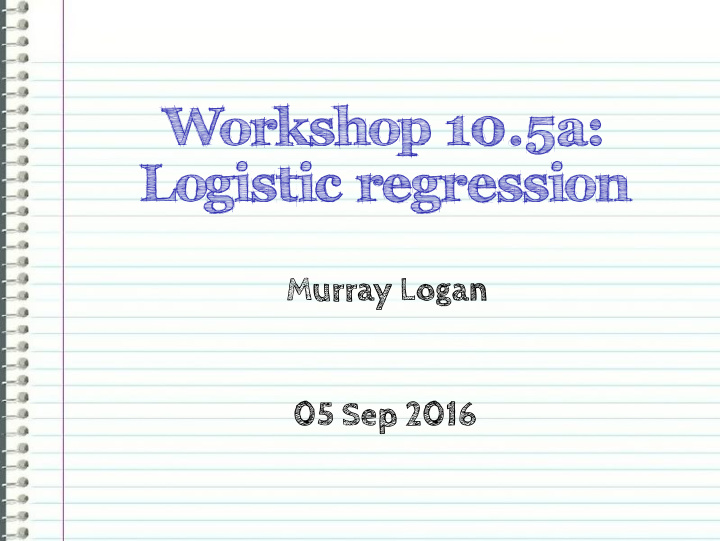



Workshop 10.5a: Logistic regression Murray Logan 05 Sep 2016
Section 1 Logistic regression
Logistic regression a d a t r y i n a B ( ) Link: log π 1 − π Transform scale of linear predictor ( −∞ , ∞ ) into that of the response (0,1)
Logistic regression a) b) Present Present Predicted probability 1.0 1.0 ● ● ● ● ● ● ● ● ● ● ● ● ● ● ● ● ● ● 0.8 of presence 0.8 0.6 0.6 0.4 0.4 0.2 0.2 Absent Absent 0.0 0.0 ● ● ● ● ● ● ● ● ● ● ● ● ● ● ● ● ● ● ● ● ● ● X X c) d)
Logistic regression Probability density function Cumulative density function n = 50 n = 20 n = 3 0 5 10 15 20 25 30 35 40 0 5 10 15 20 25 30 35 40 ( ) n p x (1 − p ) n − x E ( Y ) = x Spread assumed to be equal to mean. ( φ = 1 )
Dispersion i o n e r s i s p - d v e r O Sample more varied than expected from its mean • variability due to other unmeasured influences ◦ quasi- model • due to more zeros than expected ◦ zero-inflated model
y x 1 0 1.024733 2 0 2.696719 3 0 3.626263 4 0 4.948643 5 0 6.024718 6 0 6.254113 Logistic regression Example data 1.5 1.5 1.0 ● ●● ● ● ●● ● ● 1.0 ● ●● ● ● ●● ● ● 0.5 0.5 y y 0.0 ● ● ● ● ● ● ●● ● ● ● 0.0 ● ● ● ● ● ● ●● ● ● ● −0.5 −0.5 5 10 15 5 10 15 x x
> dat.glmL <- glm (y ~ x, data = dat, family = "binomial") Logistic regression • Fit model
> par (mfrow= c (2,2)) Logistic regression • Explore residuals > plot (dat.glmL) Residuals vs Fitted Normal Q−Q 2 2 ● 9 9 ● ● 12 12 ● 1 ● 1 ● Std. deviance resid. ● ● ● Residuals ● ● ● ● ● ● ● 0 ● ● ● ● ● 0 ● ● ● ● ● ● ● ● ● ● ● ● ● ● −1 ● −1 ● ● −2 ● 15 −2 ● 15 −6 −4 −2 0 2 4 −2 −1 0 1 2 Predicted values Theoretical Quantiles Scale−Location Residuals vs Leverage 1.5 0.5 15 ● 2 ● 9 ● 9 1 ● 12 ● ● 12 Std. deviance resid. 1.0 ● ● Std. Pearson resid. ● ● ● ● ● ● ● 0 ● ● ● ● ● ● ● ● ● ● ● ● ● −1 ● ● ● 0.5 ● ● ● ● ● ● ● −2 ● 0.5 ● 15 0.0 −3 Cook's distance 1 −6 −4 −2 0 2 4 0.00 0.05 0.10 0.15 Predicted values Leverage
> dat.resid <- sum ( resid (dat.glmL, type = "pearson")^2) [1] 0.8571451 > 1- pchisq (dat.glmL$deviance, dat.glmL$df.resid) [1] 0.8647024 Logistic regression • Explore goodness of fit • Pearsons χ 2 residuals > 1 - pchisq (dat.resid, dat.glmL$df.resid) • Deviance (G 2 )
Number of Fisher Scoring iterations: 6 Signif. codes: 0.0270 * x 0.6559 0.2936 2.234 0.0255 * --- 0 '***' 0.001 '**' 0.01 '*' 0.05 '.' 0.1 ' ' 1 3.1599 (Dispersion parameter for binomial family taken to be 1) Null deviance: 27.526 on 19 degrees of freedom Residual deviance: 11.651 on 18 degrees of freedom AIC: 15.651 -2.212 -6.9899 3Q Max glm(formula = y ~ x, family = "binomial", data = dat) Deviance Residuals: Min 1Q Median (Intercept) -1.97157 > summary (dat.glmL) -0.33665 -0.08191 0.30035 1.59628 Coefficients: Estimate Std. Error z value Pr(>|z|) Call: Logistic regression • Explore model parameters Slope parameter is on log odds-ratio scale
[1] 0.5767057 > 1-(dat.glmL$deviance/dat.glmL$null) Logistic regression • Quasi R 2 ( ) deviance quasiR 2 = 1 − null deviance
(Intercept) > -dat.glmL$coef[1]/dat.glmL$coef[2] 10.65781 Logistic regression • LD50 intercept LD 50 = − slope
Logistic regression • summary figure 1.00 ● ● ● ● ● ● ● ● ● 0.75 Y 0.50 0.25 0.00 ● ● ● ● ●● ● ● ● ● ● 5 10 15 x
Section 2 Worked Examples
Worked Examples
Recommend
More recommend